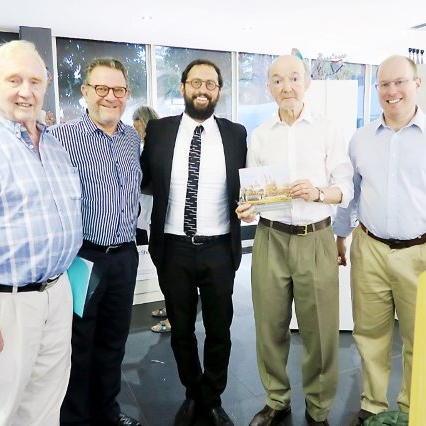click to dowload our latest edition
CLICK HERE TO SUBSCRIBE TO OUR NEWSLETTER


Published
6 years agoon
By
adminTALI FEINBERG
For years, it was assumed that the first organised Jewish document recorded was written in Cape Town in 1841, but it was discovered by Emeritus Professor Howard Phillips that the Grahamstown document preceded it.
This document, written in October 1838, was a request for a small piece of ground to be allocated to start a Jewish cemetery in Grahamstown. In this request, the signatories “were re-enacting the first duty of many fledgling Jewish communities arriving in a new environment”, says Phillips.
“As another historian points out: ‘Observing the correct procedures of a Jewish burial is a basic duty of every Jew, and this explains why the first development in every Jewish community… was the consecration of a Jewish section of the cemetery.’”
This is just one of the many facts uncovered by Phillips, who worked as a historian at the University of Cape Town (UCT) from 1974 to 2014. His new book, Cemeteries and Synagogues: The Foundation of Organized Jewry in South Africa, was launched last week at an event hosted by the Cape Town Hebrew Congregation, the Kaplan Centre for Jewish Studies (UCT) and the South African Jewish Museum.
Phillips’ link with the Cape Town Hebrew Congregation – also known as the Gardens Shul – is long. His grandfather, Joe Phillips, became a member of the congregation in 1920 after coming to South Africa from Lithuania, and he continues that membership to this day.
Rabbi Osher Feldman said it was appropriate that the book was launched under the auspices of the Gardens Shul because it is based on essays written to mark the congregation’s significant anniversaries. Also, Feldman says, “in Biblical Hebrew, there is no word for history, only the word zachor, which means memory. This is because memory is alive – it informs our future, guides us and inspires us.”
Professor Adam Mendelsohn, director of the Kaplan Centre, explains: “Phillips has uncovered and interpreted material that adds colour and nuance to our portrait of the foundation of Jewish communal life in South Africa.
“Sometimes these documents – synagogue minutes, correspondence, maps – have redrawn that picture entirely… his goal has been to illuminate and reveal.”
While it is written in a scholarly manner, the text of the book is accessible to all, and this history can clearly be divided into different periods, explains Phillips.
Describing the very earliest Jewish settlement in South Africa as “precarious”, he writes that this was the time when British and German Jews took the first tentative steps to make the country their home and begin to organise Jewish life here. They did so by setting up cemeteries and synagogues – hence the book’s title – as these were usually the first two institutions put in place wherever Jews set down roots.
The next stage of settlement would be “permanent” – this was when the first synagogue was established and when Jews began to feel at home. That first shul was the St John’s Street Synagogue, or Tikvah Israel congregation, now part of the larger Great Synagogue of the Gardens Shul.
Referring to a picture of the opening, Phillips pointed out the British leadership of the community, including the formidable Reverend Bender, while in the background is John Kent, the caretaker of the shul. Kent’s son and grandson would continue this role, and he paid tribute to the last man of that line, who only recently passed away.
The book also examines the “prestigious” period from the 1890s onwards, when Jews were accepted by the local population and seen as part of the city. This is demonstrated by the induction of the first Jewish mayor of the Cape in 1904, Mr Hyman Lieberman, the building of the Great Synagogue, and the public presence of the Jewish community in Cape Town and beyond.
The book also explores the shift from the Anglo-German dominance to “the rise of the Litvaks”, which is reflected in Phillips’ own family story.
His grandfather, Joe, was a member of the more English congregation in St John’s Street, and also of the more hamisha Ponevez Shul a few roads away, “which allowed him to keep one foot in ‘De Heim’” while he adapted to a new environment. But that would soon change as more Litvaks began to arrive, importing the South African Jewish culture that we know today.
Phillips also illustrated this point with a story of how Reverend Bender asked a child when his birthday was. “It’s on Purim,” the boy replied. The reverend, with his dominant English background, told the child that from now on, his birthday would be on ‘the Ides of March’ – and so it was!
The book concludes with a detailed look at how the Great Synagogue was built, which would fascinate historians, architects and congregants alike. Phillips closes with an explanation of how this soaring synagogue set the tone for the success of the community ahead: “It was strengthened decade by decade through the commitment of the faith of the congregation and its leaders… becoming the pillar of Jewish faith which the building represents locally, nationally and internationally. As Winston Churchill once remarked: ‘We shape our buildings, and afterwards our buildings shape us.’”
